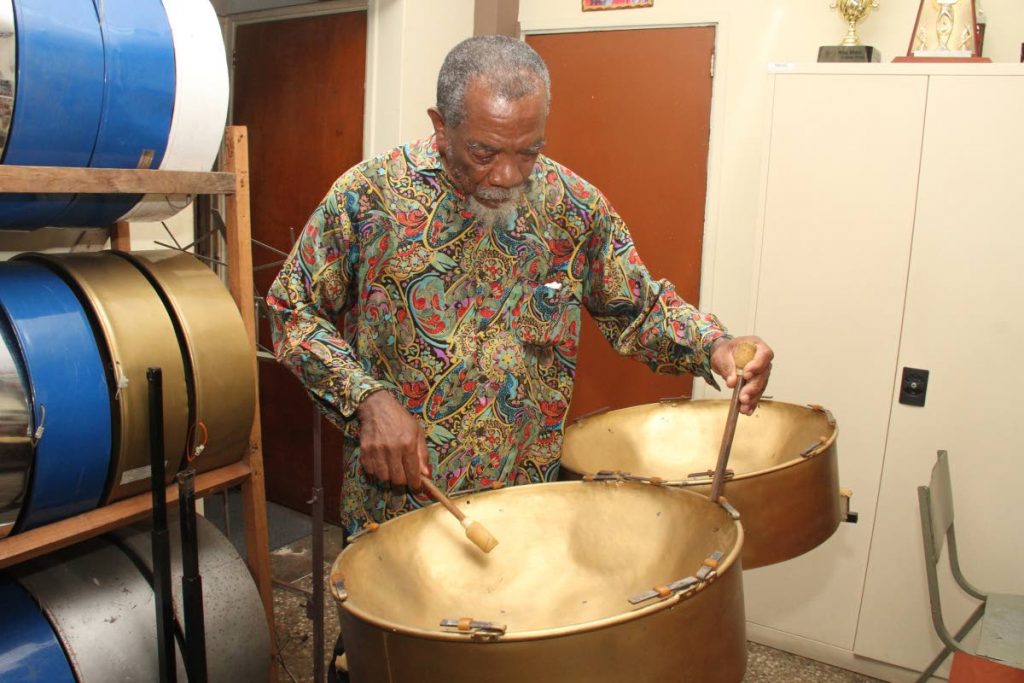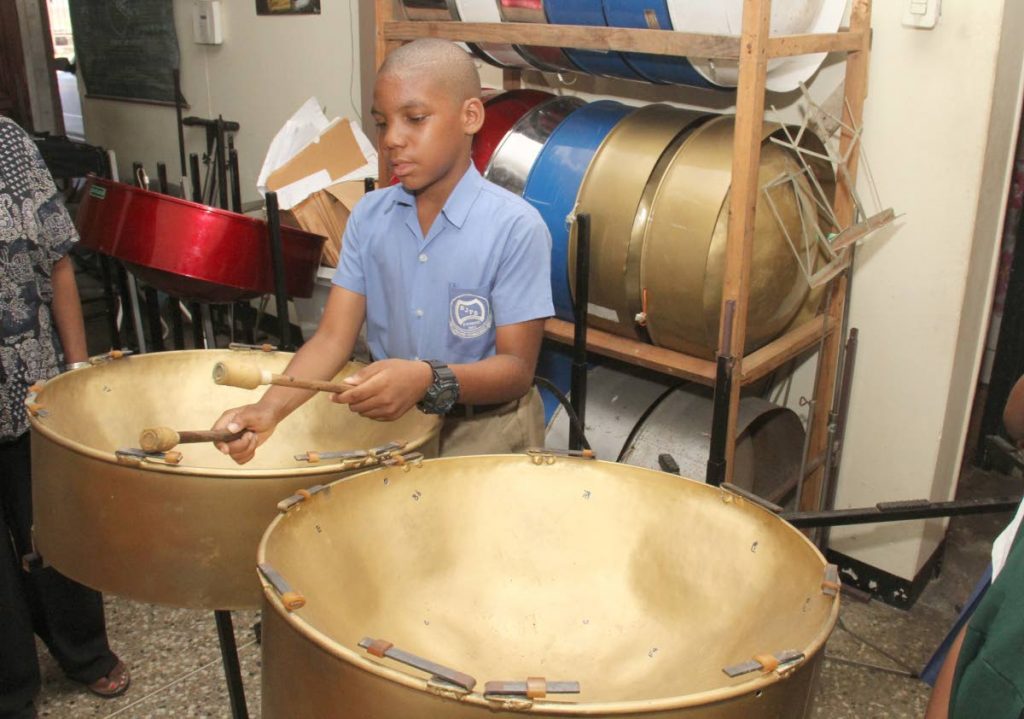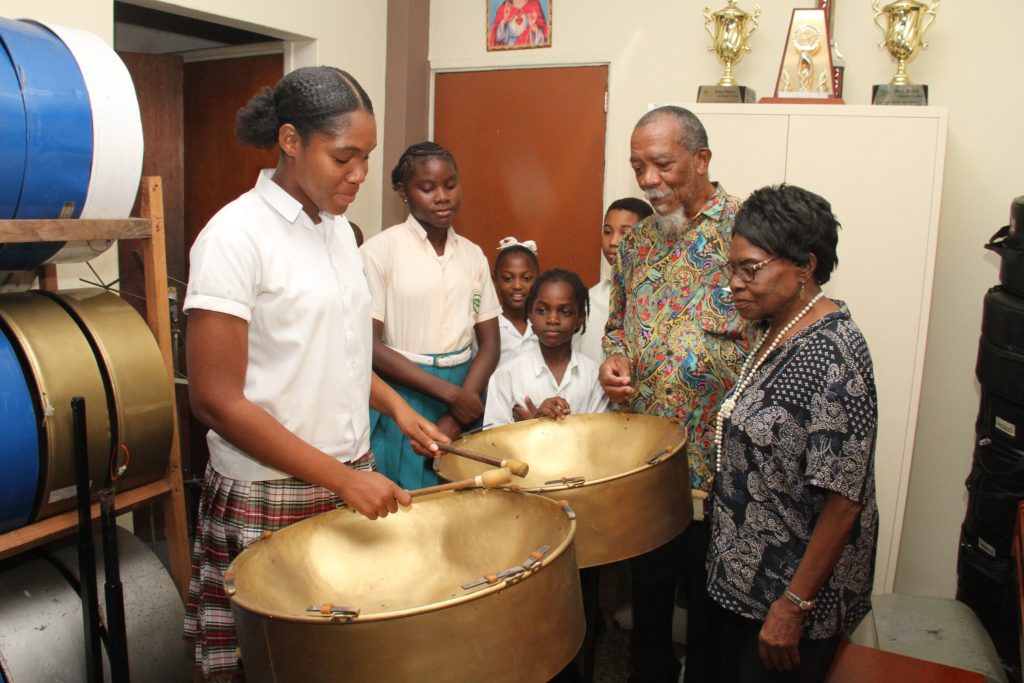Pan tuner’s ministry

In the field of pan tuning, Denzil “Dimes” Fernandez is a living legend.
Unassuming and incisive, with a gift for nuances in sound, he is regarded as a pioneer, having developed several innovations with the steelpan over the years.
Fernandez, 75, is among the last of a dying breed of veterans, whose tireless efforts and dedication to pan tuning, paved the way for the recognition the instrument now enjoys around the world.
In an interview with Sunday Newsday at St Margaret’s Boys Anglican School, Belmont, with which he has been affiliated since 2003, a concerned Fernandez spoke about the shortage of pan tuners.
“We are not in a nice position at all, taking into account the fraternity has lost about 25 tuners within the last 25 years,” he observed.
“All the masters have gone – Lincoln Noel, Bertie Marshall, Birdie Mannette. And when are we going to replace them?”
Fernandez said, however, this sad reality has not prevented him from doing his part to preserve the art of pan tuning.
If anything, the loss of some of the pan’s creative geniuses has reinforced his determination to ensure the artform’s survival, particularly in the area of tuning, pan construction and innovation.
“It is a love,” he declared.
“It is not just about money because pan tuning and construction is my ministry. This is something that is spiritual to me.
“Of course, doing the work, you need a little money to survive but for me the emphasis was never on money.”
Fernandez said St Margaret’s Boys, which has claimed 11 Panorama titles over the years, was a testing ground for his latest invention – the fusion vibe.
He is also hoping the fusion vibe will be a dominant feature of the school’s 2019 Panorama presentation, Hulk, performed by Dexter Stewart (Blaxx).
The creation, he said, has already generated a buzz among his eager charges at the school.
“I have introduced it to St Margaret’s already and of course, there is excitement. They want to get these pans.
“But for Panorama coming. I am hoping they will use a few of them in it because I intend to push that vibe.
“I already have the double tenors, seconds, guitars. And I am working on the soprano right now.”
Fernandez, who has accumulated an impressive list of achievements over the years, said he also intends to use St Margaret’s Boys as a launch pad for any future innovation. He said the fusion vibe does not alter the configuration of notes on the pan.
“The notes stay in the same position but on the rim of the pan. And, by each note, I have what is called a synergistic generator, which is really a piece of metal,” he explained.
Fernandez said “some Maths” is also involved in getting the right quality and dimensions to the metal.
“So that whatever note that you play or whatever frequency that is generated by that synergistic generator, it is going to kick off a pan note if it’s on the same frequency as the pan.”

Fernandez explained: “That means you don’t have to hit the note itself. You could just hit the synergistic generator and it kicks off the pan note of that frequency. The advantage is the difference with which the note is being excited because normally, you hit a note in the centre and it vibrates.
“In this one, you are hitting the synergistic generator and that induces the frequency into the pan so it attacks the notes from all around.”
Fernandez said the synergistic generator makes it possible for the pannist to sustain the note to get what he called “a steady state.”
This, he said, is accomplished with the use of a special stick containing resin.
“So, when you pass the stick on the synergistic generator, it sustains the notes in very much the same way a violin would sustain a note.”
A Belmont native, Fernandez has been associated with several bands in TT’s cultural capital over the years.
In 1956, at age 12, he began playing the guitar pan and four years later, made his debut in pan tuning.
Fernandez recalled he was under a chennette tree near to the panyard of the now defunct Belmont Symphony, on Fairfax Lane, off St Francois Valley Road when a prominent panman in the area placed a pan around his neck.
“I shook my head and he put the pan around my neck and showed me a few chords. There was no big set of arrangement in those days and I started to beat the pan.”
Fernandez recalled the man had complimented his performance.
“That was the start of the playing and I was on the road with Belmont Symphony in 1956.”
The pan tuner said players’ fees in those days were minuscule.
In fact, Fernandez recalled receiving $3 for playing in Belmont Symphony in 1957.
His association with St Margaret’s Boys, which he regards as his pet project, continues to grow and he has seen the fruits of his labour.

Fernandez said while some of the school’s past students are now studying music at the UTT, others have landed successful gigs at several leading conventional bands, including former Panorama champions All Stars Steel Orchestra.
However, Fernandez said he is disappointed that many of his charges do not seem interested in wanting to learn about pan tuning or construction.
“Is just two of them I know of that took courses with Pan Development Unlimited. But the rest are just interested in the actual playing.”
For this reason, Fernandez believes TT is in dire need of a pan academy, covering both tuning and construction.
He said while Pan Development Unlimited’s Barry Yeates and others are dealing with pan construction, its emphasis has never been on tuning.
“And that is because they don’t have enough time. So, we need to have more schools dealing with the teaching of pan tuning and construction.”
Fernandez said he does not support the argument that one must be involved in pan construction before becoming involved in tuning.
Acknowledging the innovations in pan tuning, Fernandez said the days of “hitting and missing” are long gone.
“You could put things now on the blackboard and go and demonstrate to your students exactly what kind of modal composite you intend to use in each pan note because when you are tuning pan, you are dealing with the harmonic spectrum. You can put in about five different frequencies in each note.”
He added: “It is scientific now. It could be explained and demonstrated. It is not just going on the pan and pondering and guessing and hoping.
“You can go by a professional pan tuner now, once it is properly prepared and he will say he putting certain notes together and you will have a balanced pan that is harmonically tuned. It is not like long time.”

Photo: Ayanna Kinsale
Fernandez said, though, not all tuners are capable of doing this.
“Tuning is one thing but being able to tune pan and teach, to impart that knowledge is another thing.”
Fernandez has tutored many courses in pan tuning in TT and overseas, and stressed that interest in the artform must be cultivated as several countries are already producing tuners. He said late pan icon Ellie Mannette produced many tuners in West Virginia, where he lived and worked for several years.
He said Switzerland has also developed its steelband programme.
“They came up with the hang pan and it is doing well and getting more and more popular. The hang pan does not have the range like our pans but it is good for certain music. They are progressing.” He said Switzerland has also developed a black steel, which enables the pan to stay in tune longer.
“So, foreigners are experimenting with the pan to come up with better quality steel.”
Regarding the future of the steelpan, Fernandez said the onus is on innovators to ensure young people maintain interest in the instrument.
“I believe once we get a few innovators who can come up with ideas, the kids are going to play but we got to push it with adequate funding.
“So, there has to be a proper parent body for the steelpan, not just to put on shows. We not dealing with pan politics. We dealing with the physics of the pan and training children to play these pans.”
For his part, Fernandez said he is currently researching sonic therapy – a process whereby the human body is healed through sound vibrations rather than pharmaceuticals.
“Why can’t we prepare the pan for that because the pan does generate a real array of frequencies?” he asked.
“We just got to make sure they are clean enough. We already know about it subjectively. It affects the human psyche with the sound. But to put it in practice, I have in mind.
“So, I want to start some research on that – to construct pans with certain frequencies because there is a whole list of frequencies of what one can used for different ailments. But you got to get people who in the medical field to deal with that. All I can do is just make the instrument.”
About Denzil Fernandez
* Denzil Fernandez composed 15 songs and calypsoes for the steel pan, of which four have been recorded. He is acclaimed for inventing the Bore Pan (July 1984): U Bass/Den Pan (January 1987); Panzer (February 1987); Bore Reed Pan (January 1988).
* Served as tuner for:
Metropolitan Symphony Steel Orchestra of Washington DC (1991-1999)
Youth Theatre Interactions, Inc, Yonkers, New York (1991).
Gaithersburg High School, Maryland, United States (1992).
Super Sonic Steel Drum Academy, Japan (1997-1999)
Conducted a series of lectures sponsored by NEM (West Indies) Insurance Ltd on standards in steel pan tuning to schools, governmental agencies and organisations.
Lectured and conducted courses for conventional musicians, high school students and students of steel pan.
Worked as a consultant for the TT Bureau of Standards in 1987 on specifications for the standardisation of the steel pan.
Was a consultant on the mechanisation of the construction of the steel pan for Metal Industries from 1988-1989.
Arranged music compositions:
Savaneths Stage Side, Belmont (1964-1966)
The Golden Tambre, Belmont ((1989-1990)
World Missions Steel Orchestra, New York (1992)
East of the River, Washington DC (1997-1999)

Comments
"Pan tuner’s ministry"